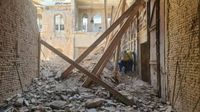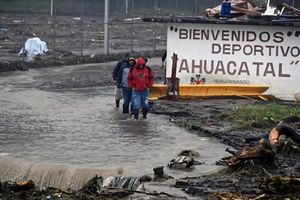On the morning of October 1, 2025, a tragic accident unfolded in the heart of Damascus, Syria, as the ceiling of the historic Grand Serail—also known as the Saraya building—collapsed during ongoing renovation works. The incident, which took place in the bustling central Marjeh Square, has left the city reeling and put a spotlight on the persistent dangers lurking within Syria’s aging, war-battered infrastructure.
The Grand Serail, a landmark dating back to the late 19th century Ottoman era, has long stood as a symbol of Damascus’s storied past. But on this fateful morning, its legacy was marred by disaster. According to state news agency SANA and as confirmed by The Syrian Observer, the ceiling gave way while workers were laboring to restore the building, which had suffered significant fire damage just months earlier, in June 2025.
Initial reports painted a grim picture: between five and six workers were believed to be trapped beneath the rubble. By midday, rescue teams had managed to extract five individuals, but the desperate search continued for at least two more, with the fate of those still missing uncertain. Tragically, two workers were confirmed dead, and at least eleven others were injured and rushed to nearby hospitals for treatment, as reported by both SANA and The Syrian Observer.
Rescue operations were fraught with peril. The head of the Syrian Civil Defense in Damascus, Hasan al-Hassan, explained to SANA that the unstable state of the building made it too risky to use heavy machinery. “The search is complicated by a reluctance to use heavy machinery out of fear that the building might collapse,” he said. This caution, while necessary, slowed efforts and heightened the sense of urgency among emergency teams and onlookers alike.
Field teams from the Syrian Civil Defence and the Arab Red Crescent, joined by the Ministry of Emergencies and Disaster Management, faced daunting challenges. The risk of further collapse loomed over every move, endangering both the trapped workers and the rescuers themselves. In response, authorities closed surrounding roads to facilitate ambulance access, evacuated nearby civilians, and deployed structural supports in a bid to stabilize the building. The Damascus Governorate and the Internal Security Directorate coordinated closely, hoping to prevent further tragedy.
Videos circulating on social media captured the chaos: thick plumes of dust billowed from the site as emergency vehicles and personnel converged on Marjeh Square. The images, shared widely by Syrians and international observers, underscored the gravity of the situation and the heroism of those risking their lives to save others.
The Grand Serail is more than just an architectural relic; it has served as the headquarters of the Syrian Ministry of Interior and, until recently, was an active seat of government. Its walls have witnessed the ebb and flow of Syrian history, from Ottoman rule to French mandate, through decades of independence and, most recently, the upheaval of civil war.
The building’s recent troubles are intertwined with the broader turmoil that has gripped Syria for over a decade. In December 2024, during the final throes of the country’s brutal 14-year conflict, a fire broke out in the Grand Serail. That same month, President Bashar al-Assad—long the autocratic ruler of Syria—was ousted by opposition groups. The fire, set against the backdrop of regime change, further weakened the already fragile structure.
Syria’s civil war, sparked by a regime crackdown on pro-democracy protests, has left an indelible mark on the nation. More than half a million people have died, and the conflict has devastated much of the country’s infrastructure. Critics argue that the Assad regime’s focus on maintaining power came at the expense of vital public works and institutional upkeep. As Interior Ministry spokesman Noureddine al-Baba pointedly stated to reporters outside the collapsed building, “The old regime neglected this building for years.”
Al-Baba’s remarks reflected a broader sentiment among many Syrians who have watched their country’s architectural and cultural heritage suffer from years of neglect and destruction. He did not mince words when describing the magnitude of the loss: “This is a national tragedy,” he said, as quoted by The Syrian Observer. He also pledged that the state would compensate the injured workers and the families of those killed, covering medical expenses and other losses incurred.
The collapse has reignited debate among activists, urban planners, and ordinary citizens about the urgent need for a comprehensive review of safety protocols in renovation projects, especially those involving historic and war-damaged sites. The risks are not hypothetical; they are painfully real, as Wednesday’s events so starkly demonstrated. Calls for reform have grown louder in the wake of the tragedy, with many demanding more stringent oversight and investment in the preservation of Syria’s architectural heritage.
Emergency officials and city authorities have moved quickly to address immediate concerns. Surrounding roads remain closed, and additional structural supports have been installed in the hope of preventing further collapse. Rescue operations are ongoing, with teams working around the clock to locate and extract any remaining individuals trapped beneath the debris. As of the latest reports, no further casualties have been confirmed, but the situation remains fluid and tense.
The incident has also drawn attention to the broader challenges facing Syria as it seeks to rebuild in the aftermath of conflict. The Grand Serail’s collapse is emblematic of a larger crisis: a nation struggling to restore its cities, heal its wounds, and preserve its history in the face of enormous obstacles. The balance between rapid reconstruction and the careful preservation of heritage sites is delicate, and missteps can have fatal consequences, as this week’s events have so tragically shown.
As the dust settles—both literally and figuratively—on Marjeh Square, the people of Damascus are left to grapple with the aftermath of yet another blow to their city. The loss of life and injury suffered by the workers is a stark reminder of the human cost of neglect, war, and the long road to recovery. For many, the collapse of the Grand Serail is not just a structural failure, but a symbol of the challenges that lie ahead for Syria as it seeks to rebuild and move forward.
While rescue efforts continue and investigations begin, one thing is clear: the events of October 1, 2025, will not soon be forgotten in Damascus. The collapse of the Grand Serail stands as both a warning and a call to action—a reminder that the preservation of history and the safety of those working to restore it must never be taken for granted.




